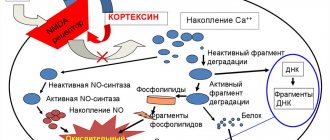Fevarin: depression and pain
The relationship between depression and pain is well known. Patients suffering from depression are significantly more likely to develop any type of pain syndrome compared to patients without depression. On the other hand, persistent pain that results in the patient's functional and social limitations often contributes to the development of depression.
Depression and pain feed each other, forming a vicious cycle. There is growing evidence that chronic pain syndromes and depressive disorders share a common neurochemical substrate (monoaminergic, mainly serotonergic and noradrenergic insufficiency). This may explain the effectiveness of medications developed to treat depression (antidepressants) on both mood and pain symptoms. A number of studies have shown that the administration of antidepressants to patients with depression and associated pain syndromes led to a decrease in depression and pain (2, 5, 11). However, the analgesic effect of antidepressants can be realized not only through the reduction of depression, but also through the own antinociceptive mechanism of antidepressants, which is not associated with depression. Studies show that prescribing antidepressants to nondepressed patients also reduces pain (12, 15).
The effectiveness of various antidepressants in treating pain varies widely. This is due to the pathophysiological heterogeneity of pain syndromes, with differences in the mechanisms of action of different antidepressants, even among drugs of the same group. In this regard, when prescribing certain antidepressants for the treatment of pain, one should rely on available research. For the first time, effectiveness in the treatment of pain syndromes, both associated and not associated with depressive disorders, was demonstrated with the use of amitriptyline, a drug from the group of tricyclic antidepressants. Unfortunately, the use of amitriptyline for pain syndromes is limited due to numerous side effects such as sedation, cognitive impairment, orthostatic hypotension, cardiac arrhythmias, dry mouth, constipation, which is associated with the affinity of tricyclic antidepressants for muscarinics, cholinergics, histamines and α1 -adrenoreceptors.
In the 80s and 90s of the last century, new classes of antidepressants were introduced into clinical practice - selective serotonin reuptake inhibitors (SSRIs) and selective serotonin and norepinephrine reuptake inhibitors (SNRIs). Due to their more favorable safety profile, these drugs have replaced older antidepressants in many situations. Selective serotonin reuptake inhibitors (SSRIs) and selective serotonin reuptake inhibitors (SNRIs) have been shown to have analgesic effects in a variety of pain syndromes. However, a number of studies have shown that SNRIs were more effective than SSRIs; in other studies, drugs from both groups showed equal effectiveness (3, 5, 7, 8).
This review presents studies that examined the effectiveness of fluvoxamine in various pain syndromes.
Mechanism of action of Fluvoxamine
Antidepressants can differ in their analgesic activity, even among drugs of the same class. Among drugs from the SSRI group, fluvoxamine has the greatest analgesic activity. A study by Schreiber (2005), which compared the analgesic activity of various SSRI antidepressants (fluvoxamine, fluoxetine, citalopram, escitalopram) in mice, showed a clear antinociceptive effect of fluvoxamine, while fluoxetine and citalopram showed a significantly weaker analgesic effect . Escitalopram in standard doses turned out to be completely ineffective, and with a significant increase in dose (at which 20% of mice died) it showed a weak analgesic effect. These data may indicate that the effect of fluvoxamine in clinical use is realized through the analgesic effect itself (possibly through the activation of descending antinociceptive systems), as well as through the reduction of depression. While the effectiveness of fluoxetine and citalopram in pain syndromes is most likely realized only through its influence on the affective component of pain. Thus, the analgesic clinical effect of fluvoxamine is more pronounced than the effectiveness of other drugs from the SSRI group. In this regard, among the SSRI drugs for the treatment of pain syndromes, fluvoxamine is the most preferable choice.
Another study by Schreiber (2006) showed that the analgesic effect of fluvoxamine was not reversed by naloxone. Thus, the mechanism of action of fluvoxamine is realized through non-opiate mechanisms. However, this study showed that fluvoxamine potentiates the action of opioid analgesics, acting mainly on kappa
-opioid receptors.
Another PET study showed that fluvoxamine administration reduced activation of brain regions involved in affective and integrative pain assessment (anterior cingulate sulcus and contralateral secondary somatosensory cortex) (10). This indicates that the effect of fluvoxamine may be due in part to a reduction in pain perception.
Fluvoxamine in the treatment of headaches
There are several studies that have demonstrated the effectiveness of fluvoxamine in the treatment of chronic headaches (chronic migraine, chronic tension-type headache, abuse headache) (2, 4, 5, 9). Frequent headache attacks often lead to excessive use of analgesics. As a result, in patients who abuse analgesics, the central regulation of pain sensitivity is disrupted and serotonin reserves in the central nervous system are depleted. In response, an increase in the number of postsynaptic serotonin receptors in the brain and vascular wall and an increase in their sensitivity to endogenous and exogenous trigger factors leads to an increase in headache attacks. Treatment tactics for this category of patients involve complete abolition of the drug, which is an abuse factor, and the prescription of antidepressants, anticonvulsants or beta blockers. In the work of Skoromets et al. (2008) compared the use of Fevarin (fluvoxamine) and amitriptyline for chronic daily headache. Both drugs were found to be highly effective in patients who completed the course of treatment. However, only 55% of patients in the group taking amitriptyline were able to complete treatment (the effectiveness of amitriptyline was manifested only at a dose above 50 mg, which was difficult to tolerate; as a result, many patients were unable to complete the course of treatment). While Fevarin® (fluvoxamine) in average therapeutic doses was well tolerated by the majority of patients with chronic headache, which made it possible for 75% of patients with abusive headache to stop taking analgesics. Based on the results obtained, the authors concluded that Fevarin® at a dose of 50-100 mg/day. can be recommended as a highly effective adjuvant agent for the treatment of chronic daily headaches and frequent headaches (2).
Previously, in a double-blind, placebo-controlled study, Bank (1994) showed that amitriptyline and fluvoxamine were able to reduce the number and intensity of migraine attacks. However, the study authors noted that treatment with fluvoxamine is more preferable due to fewer side effects (4).
In the work of Manna et al. (1994) revealed the effectiveness of fluvoxamine in the treatment of tension-type headaches, and the effect was more pronounced in patients with severe pain, but who did not have depression, on the basis of which the authors concluded that insufficiency of the antinociceptive serotonergic descending system plays an important role in the pathogenesis of tension headaches .
A study by Hardianto-Putra (2007) showed that in patients with chronic pain (mainly migraine) who also suffered from depression, treatment was more effective in the group taking fluvoxamine compared to the group taking amitriptyline. The authors suggest that the effect of fluvoxamine may be associated with activation of brain areas responsible for the affective evaluation of pain, as well as activation of the antinociceptive descending serotonergic system (5).
Fluvoxamine in the treatment of nonspecific pain syndromes
Research shows that up to 80% of patients with depression who visit their general practitioner have purely physical complaints, such as headaches, abdominal pain, muscle pain in the back, joints, and neck (6 ). Such patients pose a problem for the practitioner, since the absence of psychological complaints masks depression (masked depression), forcing the doctor to look for a somatic cause of the existing algic manifestations. However, a persistent search for somatic pathology does not bring results, and the use of analgesics is unsuccessful.
It is assumed that this kind of somatic manifestations (sometimes the term nonspecific pain is used to refer to them) may be due to insufficiency of antinociceptive descending systems, as a result of which ordinary sensory stimuli from the internal organs may be perceived as painful. In this situation, the most appropriate is the use of antidepressants, including fluvoxamine (1).
Fluvoxamine in the treatment of other pain syndromes
Fluvoxamine has been shown to be effective for pain associated with hip and knee arthritis in a double-blind, placebo-controlled study (12). There were no statistically significant differences between the fluvoxamine group and the placebo group in pain levels. At the same time, an improvement in functional activity was shown by 70% in the group of patients taking fluvoxamine, while in the group taking placebo the effectiveness was 44%. There were no severe side effects associated with fluvoxamine during the study. Given the good effect of using fluvoxamine in combination with a low number of side effects, the authors propose the use of fluvoxamine as a pharmacoeffective agent in patients with chronic pain due to arthritis of the hip and knee joint.
Fluvoxamine for somatoform pain disorder
There are studies that have shown the effectiveness of fluvoxamine for idiopathic genital pain (prostatodynia) (16, 17). According to the DSM-IV classification, prostatodynia is classified as a somatoform pain disorder. This disease is characterized by a chronic course and is difficult to treat (traditional approaches to treatment, the prescription of NSAIDs and antibiotics, are ineffective), which forces patients to resort to orchidectomy or even prostatectomy. But these measures often only make the situation worse. A pilot study by Turkington (1992) demonstrated the effectiveness of fluvoxamine in eliminating both pain and urological manifestations of the disease. This led the authors to conduct a double-blind, placebo-controlled study, which demonstrated a clear effect of fluvoxamine in patients with prostatodynia who underwent treatment (17). The authors draw attention to the high percentage of early treatment interruption in this category of patients. However, the researchers note, if patients can be persuaded to tolerate early side effects, the use of fluvoxamine is compensated by a good clinical effect.
Fluvoxamine for post-stroke central pain
Central post-stroke pain is a rare but difficult-to-treat disease. The use of fluvoxamine significantly reduced pain intensity from 7.7 to 6.0 points on the VAS scale in patients with post-stroke central pain up to 1 year old; in patients with a stroke duration of more than 1 year, no reduction in pain intensity was found (in a study conducted by Shimodozono, 2002). At the same time, patients also noted a decrease in depression levels. However, reductions in depression levels did not correlate with reductions in pain levels. The authors concluded that fluvoxamine can be used to control post-stroke central pain, at least in patients with a short history of stroke.
Fluvoxamine for postherpetic neuralgia
Two cases of effective pain relief in postherpetic neuralgia with the use of fluvoxamine have been described (11). In the first case, the effect was detected on the 14th day of using Fevarin at a dose of 50 mg/day; in the second case, the pain was relieved by using fluvoxamine on the 10th day (in the second case, the dose of the drug was gradually increased from 25 mg to 75 mg/day). In both cases, the reduction in pain was accompanied by a reduction in depression.
Safety
The selectivity of fluvoxamine determines its better safety profile compared to tricyclic antidepressants.
Caution should be exercised when using fluvoxamine with other drugs. In addition to the interaction features described in the instructions for use, you should pay attention to the danger of combining fluvoxamine with tizanidine (Sirdalud).
Finnish scientists have found that fluvoxamine seriously increases the concentration of tizanidine in the blood, and therefore the combined use of fluvoxamine with tizanidine can lead to a severe and prolonged decrease in blood pressure and strongly potentiates the effects on the central nervous system. This previously unknown interaction may be dangerous, especially among elderly patients. In this regard, the combined use of fluvoxamine and tizanidine should be avoided.
Conclusion
Fluvoxamine belongs to the class of antidepressants – selective serotonin reuptake inhibitors. Despite the selectivity in clinical studies, fluvoxamine has been shown to be effective in a number of pain syndromes, comparable or even superior to the effect of amitriptyline (with a more favorable safety profile of fluvoxamine). Further research is needed to clarify the effectiveness, dosing methods and safety of fluvoxamine for various pain syndromes.
The drug "Fevarin": contraindications, side effects
Like most medications, this drug has side effects. Most often, patients complain of drowsiness, apathy and nausea as a result of taking the medication we are considering. Fluctuations in body weight and manifestations of disorders in the digestive and autonomic systems were also noted.
In addition, as evidenced by reviews, some patients experienced increased nervousness, insomnia, causeless anxiety and even hallucinations. But, according to the instructions for use available for the drug “Fevarin”, such manifestations should simply be endured, because after a couple of weeks they go away. If improvement does not occur, you should inform your doctor about this to review the dosage or discontinue this drug.
How is Fevarin prescribed to older people?
For older people, the described drug is also an effective remedy in the fight against anxiety disorders and depression.
By the way, Fevarin tablets and capsules against anxiety in elderly patients are used much more often in psychiatric practice than for treating children. And if you consider that this remedy not only helps relieve symptoms of depression or panic attacks, but also has a positive effect on the quality of life, then in some cases it turns out to be completely indispensable for older people.




